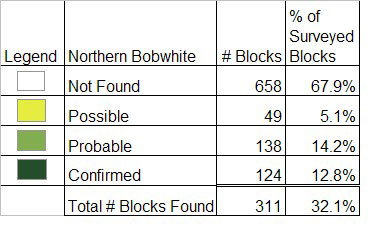Breeding Bird Atlases (BBA)
Find a Bird - BBA1
Breeding Bird Atlas 1 Species Accounts
Northern Bobwhite
Colinus virginianus
Egg Dates
May 11 to September 14
Number of Broods
one or two

In areas where bobwhites are common, their loud, cheerful whistle is one of the most distinctive sounds of summer. Although bobwhites were once abundant throughout Massachusetts, by the mid-1800s over-hunting and a series of severe winters had resulted in a dramatic decline in the numbers of this appealing species. Attempts to restore the population through an introduction of southern (but less hardy) birds served only to weaken the stock, and a complete recovery never materialized. Today, this popular quail is common only in southeastern portions of the state. Elsewhere, it is a rather rare and sporadic resident whose presence is usually the result of captive-bred birds that have escaped or been released for field trials.
Bobwhites inhabit a variety of open habitats—weedy fields, overgrown pastures, farms, open woodlands, and clearings along power lines. Dense patches of brush and hedgerows within these habitats are important for providing cover and protection from the many predators that find these plump birds to be desirable and vulnerable prey.
The unmistakable call is a robust, whistled bob-white or bob-bob-white, ascending sharply on the final note. A soft three-note assembly call is used when pairs or covey members have become separated, and a variety of other soft conversational notes also are given. The male performs a courtship display in which he spreads his wings with the tips touching the ground, fans his tail, and bows before the female, turning his head to show off his white markings. Mated pairs establish territories of about an acre in size.
The nest is a shallow depression on the ground, arched over with grasses, with an opening on the side. The usual clutch size is 14 to 16 eggs, but as many as 30 eggs have been found in a nest, usually the product of two females. In Massachusetts, the peak period of laying is the last part of June. Both sexes share the 23- to 24-day incubation period. The young are precocial and can fly when they are about 14 days old, following which some parents will raise a second brood. When danger threatens the young, the adults will use a crippled-wing display in an attempt to lure the predator away. Nonetheless, as with most ground nesters, mortality of both eggs and young is high. The young are full grown at about 49 days of age.
Throughout much of the year, bobwhites are very gregarious, and, when nesting is finished, family groups gather into coveys of up to 30 birds. During the night, they roost in a tight circle, each bird facing out, thereby providing protection from predators and conserving heat. Quail are nonmigratory, and coveys rarely travel more than half a mile from the breeding territories. However, when food becomes scarce, they may move on foot to new areas. They are common visitors at winter feeding stations on the Cape, where they are much enjoyed and appreciated by their human benefactors.
Map Legend and Data Summary
Atlas 1 data collected from 1975-1979


Note: common in open areas of southeastern region; uncommon or rare elsewhere
Blair Nikula



